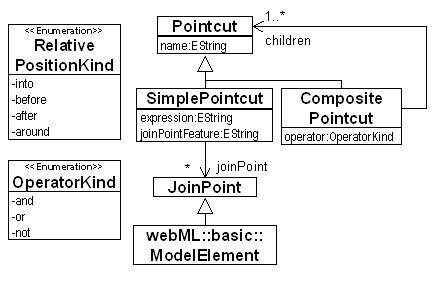
| Overview | Parentpackage |

The aspectualSubject package encompasses the concepts required for identifying where to apply
an Advice.
| Class Summary | |
|---|---|
| Pointcut | To which ConcernModule a Pointcut applies is determined by the CompositionPlan, i.e., the WebML Model (or to a prior result of a composition) to which the Aspect is applied. |
| SimplePointcut | The SimplePointcut concept has been defined to represent a set of JoinPoints which
are selected according to a certain quantification method (OCL-based, Enumeration-based). Constraints:
|
| CompositePointcut | For reuse purposes, modelers are allowed to define CompositePointcuts which are composed of
other SimplePointcuts and/or CompositePointcuts by means of logical operators, e.g., AND, OR,
NOT. |
| JoinPoint | A JoinPoint is a well-defined place in a ConcernModule, or rather an instance of
a modeling concept belonging to the WebML language. This means, that any instance of a modeling
element from the WebML language, whether it is defined in a WebML model or an Advice,
can serve as a JoinPoint at some point in the CompositionPlan |
| Enumeration Summary | |
|---|---|
| RelativePositionKind | Denotes the allowed relative positions with respect to the JoinPoints
where the Advice shall be introduced. |
| OperatorKind | The allowed logical operators to compose CompositePointcuts. |